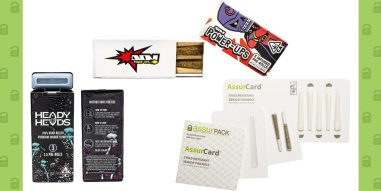Busting the Myths of Sustainable Packaging
March 8, 2023
At AssurPack®, we have many types of sustainable packaging, yet we get non-stop requests for hemp-based plastics and so-called “biodegradable packaging.”
And while the idea of hemp cannabis packaging may sound great, there are some drawbacks to these technologies.
So, before you go all-in on a new biodegradable package or hemp-based cannabis package, read this post. It explains why we prefer other approaches to sustainability — and why you should too.
Ask Yourself: Why Do You Want Sustainable Packaging?
It’s awesome that you’re considering environmentally friendly packaging. We’re behind you all the way.
Our package engineers are constantly working to reduce our impact with recycled plastics, bio-plastic blends, sustainably sourced paperboard, etc.
However, if your sustainability aspirations are focused on brand image, you would do well to reconsider.
It’s true — consumers value sustainability, especially in the cannabis industry. Yet sadly, for most consumers, it’s last on their list of priorities according to the McKinsey & Company market research group.
When asked about packaging, survey respondents ranked “environmental impact” lower than all other criteria, as shown below.
Consumer Packaging Preferences Ranked
- Hygiene and safety (rated most important)
- Shelf life
- Ease of use
- Durability
- Information on the label
- Appearance
- Environmental impact (rated least important)
These results demonstrate why it’s so important for you — the product manufacturer — to make sustainability a priority; your customers may not do the same.
So when choosing cannabis packaging, remember that your sustainability choices are serving the environment more so than consumer preferences. Most consumers see sustainability as a bonus — not a primary purchasing criterion.
Serving Your Customers AND the Environment
A sustainable package should perform well. If your package is difficult to use or compromises your product’s shelf life, people will notice, and they may avoid your brand in the future.
That’s why our designers hesitate to use hemp-based plastics and biodegradable packaging. These materials either don’t meet our performance standards or aren’t as sustainable as they seem.
Instead, we solve the problems of sustainability using other materials and techniques. Here’s why.
Biodegradable Packaging… Isn’t
You’d think that biodegradable packaging would be compostable — that it would return to the earth as a rich fertilizer for your backyard garden.
The truth is very different. While it’s true that a package may be “biodegradable,” the term applies in a very specific way in the packaging industry.
Yes, these packages are biodegradable, but only in industrial composting facilities. Without specialized equipment and heat-driven processes, biodegradable plastic is essentially the same as its conventional counterpart.
Worse still, biodegradable packaging cannot be recycled. Many consumers make the mistake of disposing of these packages in the recycling bin or, if they believe the package will naturally biodegrade, throwing them in the trash.
The reality is that most biodegradable packaging — at its current level of development — has no place within a circular economy of materials. It’s not recyclable. And there’s no chance that consumers will seek out the few industrial facilities that can compost this type of plastic.
Our Solution for Biodegradable Packaging
The package engineers here at AssurPack® have a better way to send plastics back to the earth. It’s a special polymer additive called BioSphere®.
We add BioSphere® to our conventional plastics to expedite their decomposition while maintaining their recyclability.
BioSphere® speeds decomposition because it attracts landfill microbes. So, if your customers throw your package away, BioSphere® attracts dozens of species of landfill microbes that “eat” the plastic, causing it to break down decades sooner than normal plastic.
The best part is that BioSphere® is recyclable — unlike “biodegradable” packaging. And it does not affect the package’s performance, food safety, or longevity outside the landfill.
The Problem with Hemp-Based Cannabis Packaging
We’d love to offer a hemp-based package. And we’re keeping a watchful eye on hemp-plastic technologies as they evolve.
But for now, we prefer recycled and recyclable plastics with special sustainability features.
The first reason we avoid hemp-based plastics is their manufacturability. Manufacturability is a big word describing how a polymer flows, molds, and sets during production. A conventional plastic like polypropylene is very moldable and capable of precise shaping and sizing.
Hemp packages are difficult to mold and aren’t as strong as our recycled options. That means a hemp-based plastic closure won’t seal as well as conventional or recycled plastic. It’s not as airtight.
The second reason we question hemp packaging is its structural integrity — or lack thereof. It isn’t as strong as recycled or virgin polymers.
The Best Alternatives to Hemp-Based Cannabis Packaging
We have two ways that we overcome the challenges of hemp-based packaging. The first is simple recycling.
We use recycled, recyclable plastics in many of our packages. This strategy keeps plastics out of landfills indefinitely. And if consumers do throw away your packaging, the BioSphere® additive ensures that it will break down decades faster in landfills.
Moreover, we’re using bioplastics to get the best of both worlds. Our SecurSlide® BP features 50% wheat straw resin and 50% conventional plastic. The blend of materials maintains the strength and recyclability of normal plastic.
The SecurSlide® BP bioplastic blend cuts plastic use in half while maintaining the strength and recyclability of the original version of the SecurSlide®. We like to think it’s the best of both worlds.
Some Deeper Thoughts About Sustainability
Sustainability goes beyond materials science. Other factors apply too.
How efficient is a package to ship?
If your package takes up less room in the shipping box, it uses fewer resources to reach its destination — and cuts your shipping fees too. Many of our packages ship flat or stack together for better.
Are recycling facilities actually available?
In many areas, they aren’t. And industrial composting facilities aren’t available to consumers who purchase “biodegradable” packaging.
Will customers reuse your package?
Hopefully. When consumers reuse packaging it keeps waste out of landfills forever. The trick is making packaging that’s cool enough to keep around — like our matchbox SecurSlide.
How are materials sourced?
We use sustainably sourced paperboard that’s certified by the Forest Stewardship Council. Beyond that, our recycled/recyclable plastics are the best solution for closing the loop on packaging waste.
Go Green Today
We believe that sustainability is more than a buzzword or marketing ploy. If you feel the same, let’s connect. Our representative can help you assess your current stewardship plan and how you can reduce your impact without increasing your costs.
Contact us today for a free consultation and samples of our packages.




